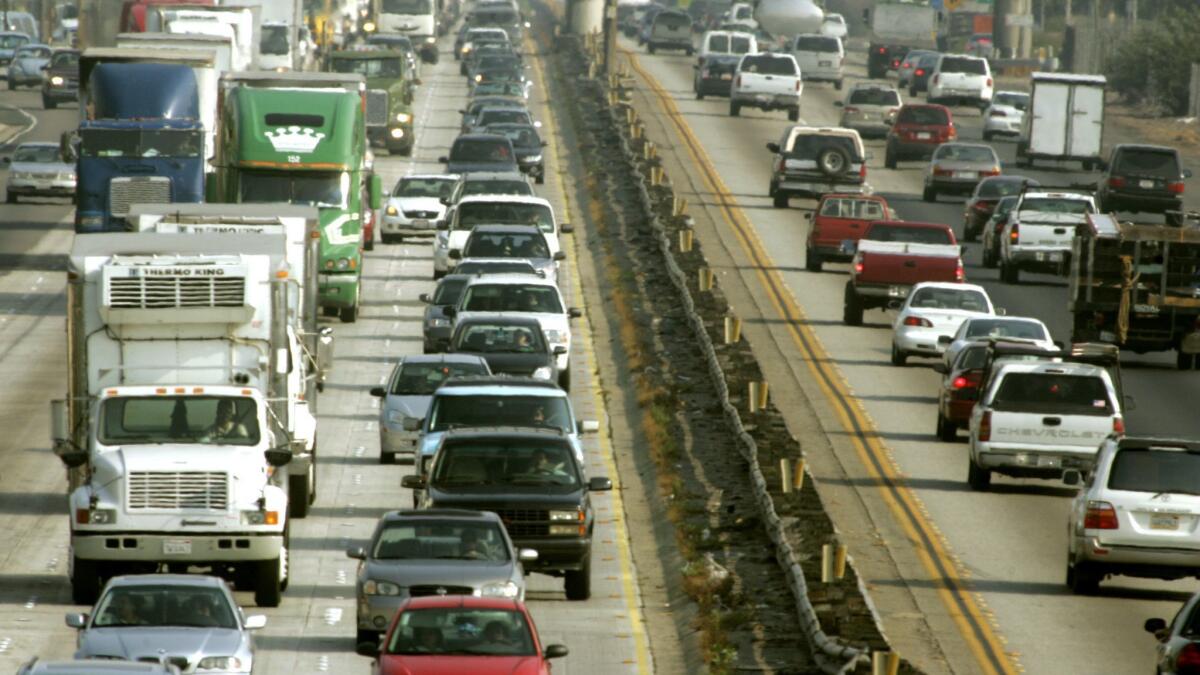Trump administration shifts course on weakening auto standards

- Share via
The Trump administration is planning to require automakers to modestly bolster fuel economy and pare tailpipe emissions after 2020, a reversal from its earlier proposal to freeze requirements through 2026.
Administration officials have tentatively agreed to the change, according to a person familiar with the matter who asked for anonymity because the deliberations are private.
The moderation of the rollback comes amid a widening schism in the auto industry over Trump’s plan to slash the fuel-efficiency standards, and strip California of its authority to regulate tailpipe greenhouse gas emissions.
At issue is a proposal from the U.S. Environmental Protection Agency and Transportation Department to ease Obama-era greenhouse gas emission and fuel economy standards.
Under the August 2018 proposal, those requirements would have been capped at a 37-mile-per-gallon fleetwide average after 2020, rather than increasing to roughly 50 mpg by 2025, as under current regulations set during the Obama administration.
Administration officials now plan to require 1.5% annual increases in fleetwide efficiency of new autos. EPA Administrator Andrew Wheeler has telegraphed the shift, which was reported by the Wall Street Journal on Thursday evening, saying the final plan will not look exactly like the proposal advanced in August 2018.
The latest plan could still change before the final rule is published.
In a related action, the administration in September moved to strip California of its authority to limit greenhouse gas emissions from vehicles. More than 20 states and several environmental organizations have challenged the administration’s action in separate lawsuits.
The Trump administration argued its original proposal would lower costs and save lives by encouraging motorists to replace older, less-safe vehicles with newer models. But that led to fierce criticism from environmentalists and California officials, who said it would increase pollution. Some automakers objected to the proposed freeze and urged the White House to soften the measure, saying they would favor rules that supported annual fuel efficiency gains and emissions reductions.
“The Trump administration is focusing on finalizing the SAFE rule, which will deliver one national standard to the American auto market,” said EPA spokesman Michael Abboud. A spokesman for the National Highway Traffic Safety Administration, the Transportation Department agency responsible for its share of the rule, declined to comment.
While the plan amounts to a less-aggressive rollback, environmental and consumer advocates warned it would still produce negative outcomes. Consumer Reports estimated consumers would spend $3,200 more in fuel costs under the plan than under the current standards for a model year 2026 vehicle, for example.
“A rollback on the scale reported would result in millions of tons of additional carbon pollution in the air and higher costs for drivers at the pump,” Luke Tonachel, director for clean cars and clean fuels at the Natural Resources Defense Council said in a statement. “This plan is absurd and calling it anything other than a disaster for our climate is ridiculous.”
Stanley Young, spokesman for the California Air Resources Board, said a federal rule cutting emissions 1.5% per year isn’t enough for the state to meet its air quality and climate change goals.
“The rumored federal proposal would compromise our ability to meet federal air quality standards and would directly impact public health,” he said in an email.
While auto industry groups have repeatedly said they support fuel efficiency improvements, Gloria Bergquist, a spokeswoman for the Alliance of Automobile Manufacturers, said the group wanted to see the full details in the final rule before taking a position.
“We are pleased that the administration seems focused on increasing standards while still aligning them with the marketplace and what consumers are buying,” she said.
Ford Motor Co., Volkswagen AG, BMW AG and Honda Motor Co. in July rejected Trump’s proposal and agreed to compromise efficiency standards — including 3.7% annual stringency gains — offered by California regulators.
Earlier this week, a separate coalition including General Motors Co., Toyota Motor Corp., Fiat Chrysler Automobiles NV and several other carmakers moved to back the Trump administration in one of the lawsuits to block its rule to strip California of its tailpipe powers.
Beene and Dlouhy write for Bloomberg.
More to Read
Inside the business of entertainment
The Wide Shot brings you news, analysis and insights on everything from streaming wars to production — and what it all means for the future.
You may occasionally receive promotional content from the Los Angeles Times.









